2008 NISSAN ROGUE seats
[x] Cancel search: seatsPage 35 of 309
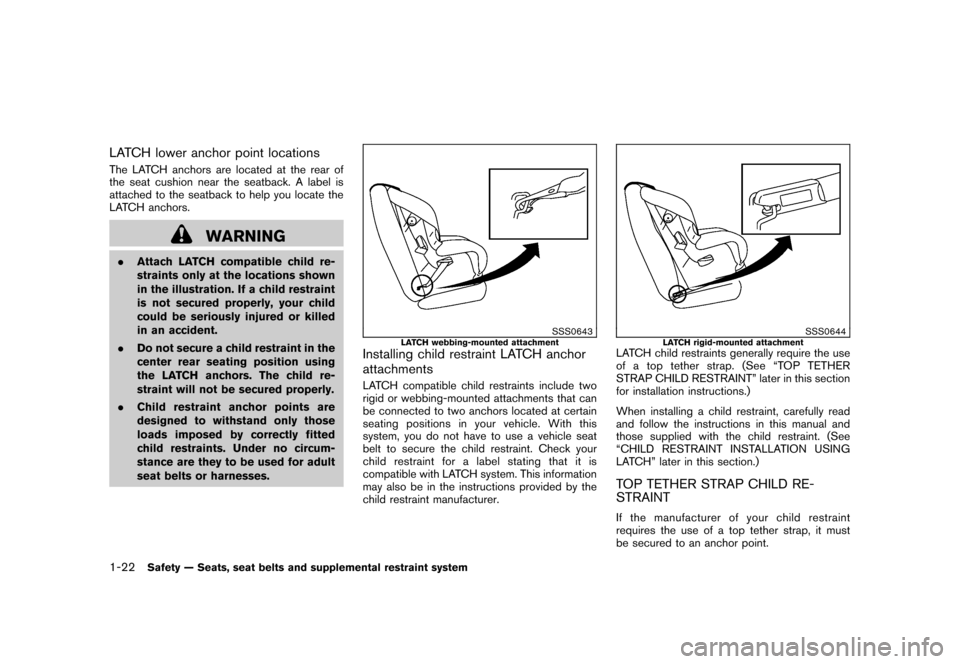
Black plate (34,1)
Model "S35-D" EDITED: 2007/ 12/ 19
LATCH lower anchor point locationsThe LATCH anchors are located at the rear of
the seat cushion near the seatback. A label is
attached to the seatback to help you locate the
LATCH anchors.
WARNING
.Attach LATCH compatible child re-
straints only at the locations shown
in the illustration. If a child restraint
is not secured properly, your child
could be seriously injured or killed
in an accident.
.Do not secure a child restraint in the
center rear seating position using
the LATCH anchors. The child re-
straint will not be secured properly.
.Child restraint anchor points are
designed to withstand only those
loads imposed by correctly fitted
child restraints. Under no circum-
stance are they to be used for adult
seat belts or harnesses.
SSS0643
LATCH webbing-mounted attachment
Installing child restraint LATCH anchor
attachmentsLATCH compatible child restraints include two
rigid or webbing-mounted attachments that can
be connected to two anchors located at certain
seating positions in your vehicle. With this
system, you do not have to use a vehicle seat
belt to secure the child restraint. Check your
child restraint for a label stating that it is
compatible with LATCH system. This information
may also be in the instructions provided by the
child restraint manufacturer.
SSS0644
LATCH rigid-mounted attachment
LATCH child restraints generally require the use
of a top tether strap. (See “TOP TETHER
STRAP CHILD RESTRAINT” later in this section
for installation instructions.)
When installing a child restraint, carefully read
and follow the instructions in this manual and
those supplied with the child restraint. (See
“CHILD RESTRAINT INSTALLATION USING
LATCH” later in this section.)TOP TETHER STRAP CHILD RE-
STRAINTIf the manufacturer of your child restraint
requires the use of a top tether strap, it must
be secured to an anchor point.
1-22
Safety — Seats, seat belts and supplemental restraint system
Page 36 of 309
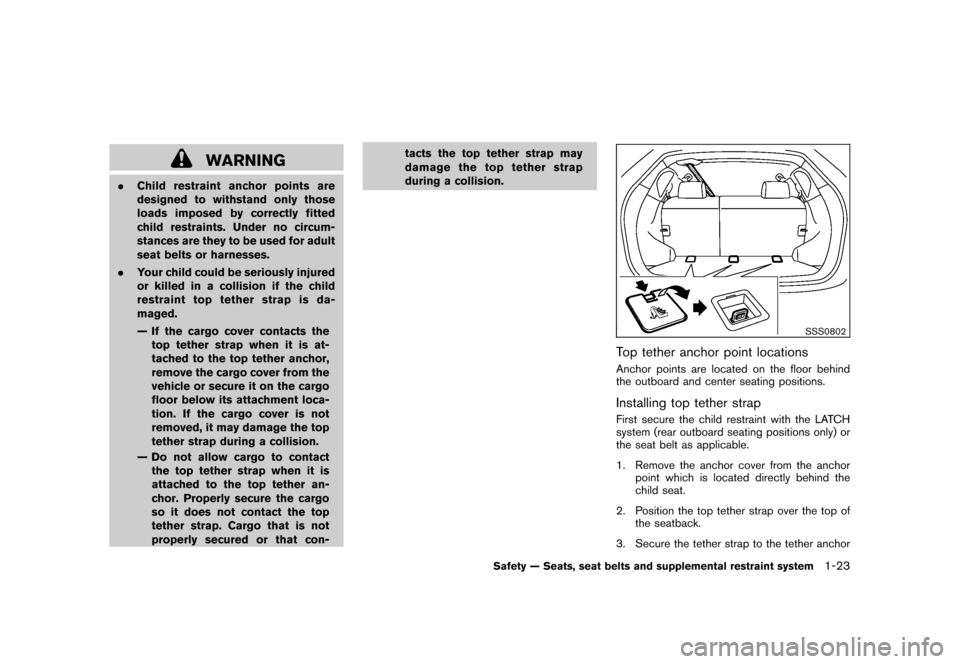
Black plate (35,1)
Model "S35-D" EDITED: 2007/ 12/ 19
WARNING
.Child restraint anchor points are
designed to withstand only those
loads imposed by correctly fitted
child restraints. Under no circum-
stances are they to be used for adult
seat belts or harnesses.
.Your child could be seriously injured
or killed in a collision if the child
restraint top tether strap is da-
maged.
— If the cargo cover contacts the
top tether strap when it is at-
tached to the top tether anchor,
remove the cargo cover from the
vehicle or secure it on the cargo
floor below its attachment loca-
tion. If the cargo cover is not
removed, it may damage the top
tether strap during a collision.
— Do not allow cargo to contact
the top tether strap when it is
attached to the top tether an-
chor. Properly secure the cargo
so it does not contact the top
tether strap. Cargo that is not
properly secured or that con-tacts the top tether strap may
damage the top tether strap
during a collision.
SSS0802
Top tether anchor point locationsAnchor points are located on the floor behind
the outboard and center seating positions.Installing top tether strapFirst secure the child restraint with the LATCH
system (rear outboard seating positions only) or
the seat belt as applicable.
1. Remove the anchor cover from the anchor
point which is located directly behind the
child seat.
2. Position the top tether strap over the top of
the seatback.
3. Secure the tether strap to the tether anchor
Safety — Seats, seat belts and supplemental restraint system
1-23
Page 37 of 309
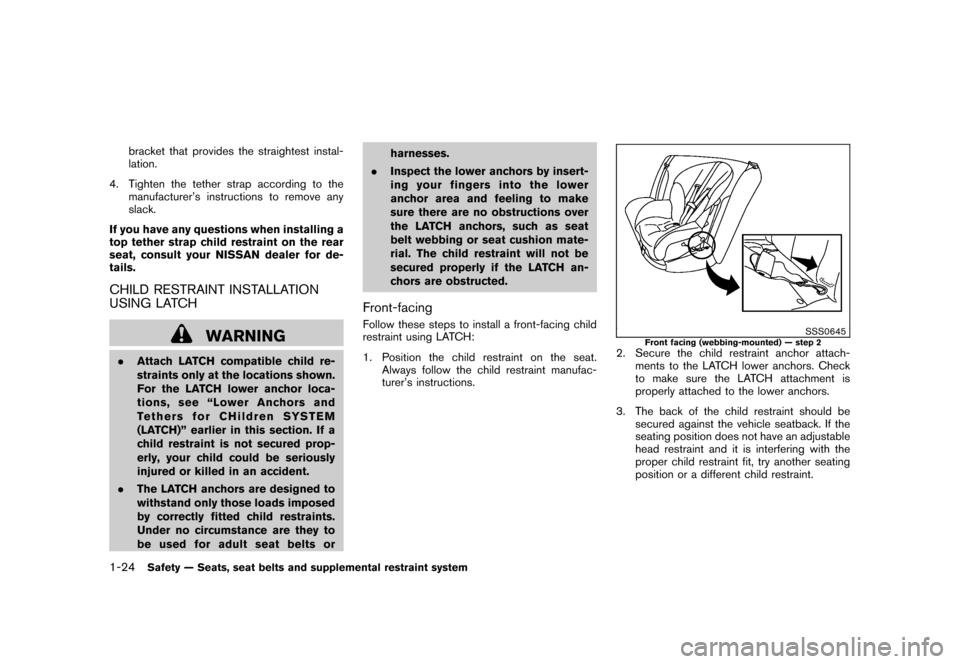
Black plate (36,1)
Model "S35-D" EDITED: 2007/ 12/ 19
bracket that provides the straightest instal-
lation.
4. Tighten the tether strap according to the
manufacturer’s instructions to remove any
slack.
If you have any questions when installing a
top tether strap child restraint on the rear
seat, consult your NISSAN dealer for de-
tails.
CHILD RESTRAINT INSTALLATION
USING LATCH
WARNING
.Attach LATCH compatible child re-
straints only at the locations shown.
For the LATCH lower anchor loca-
tions, see “Lower Anchors and
Tethers for CHildren SYSTEM
(LATCH)” earlier in this section. If a
child restraint is not secured prop-
erly, your child could be seriously
injured or killed in an accident.
.The LATCH anchors are designed to
withstand only those loads imposed
by correctly fitted child restraints.
Under no circumstance are they to
be used for adult seat belts orharnesses.
.Inspect the lower anchors by insert-
ing your fingers into the lower
anchor area and feeling to make
sure there are no obstructions over
the LATCH anchors, such as seat
belt webbing or seat cushion mate-
rial. The child restraint will not be
secured properly if the LATCH an-
chors are obstructed.
Front-facingFollow these steps to install a front-facing child
restraint using LATCH:
1. Position the child restraint on the seat.
Always follow the child restraint manufac-
turer’s instructions.
SSS0645
Front facing (webbing-mounted) — step 2
2. Secure the child restraint anchor attach-
ments to the LATCH lower anchors. Check
to make sure the LATCH attachment is
properly attached to the lower anchors.
3. The back of the child restraint should be
secured against the vehicle seatback. If the
seating position does not have an adjustable
head restraint and it is interfering with the
proper child restraint fit, try another seating
position or a different child restraint.
1-24
Safety — Seats, seat belts and supplemental restraint system
Page 38 of 309
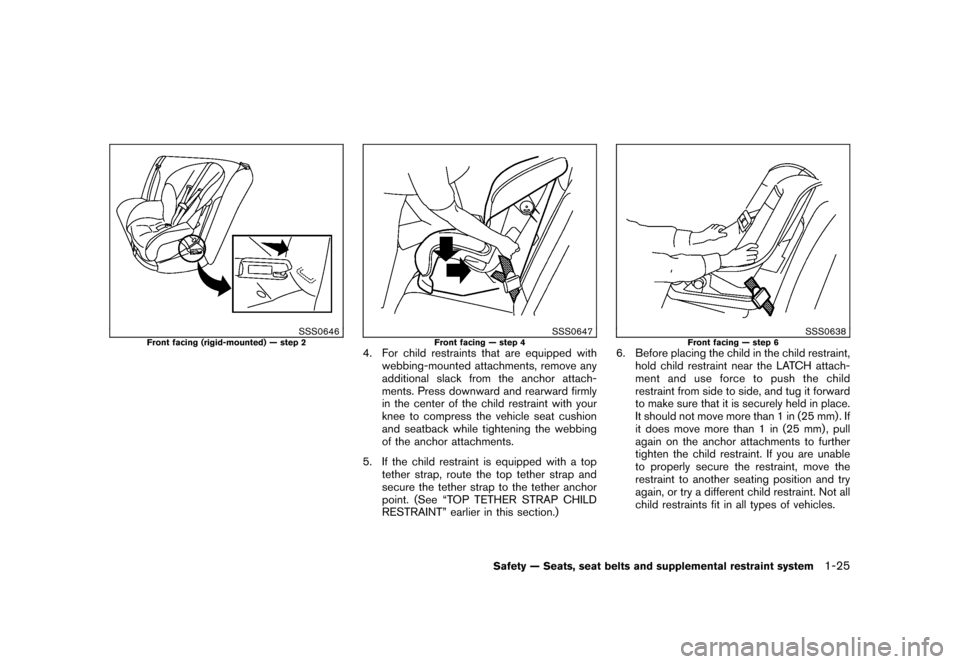
Black plate (37,1)
Model "S35-D" EDITED: 2007/ 12/ 19
SSS0646
Front facing (rigid-mounted) — step 2
SSS0647
Front facing — step 4
4. For child restraints that are equipped with
webbing-mounted attachments, remove any
additional slack from the anchor attach-
ments. Press downward and rearward firmly
in the center of the child restraint with your
knee to compress the vehicle seat cushion
and seatback while tightening the webbing
of the anchor attachments.
5. If the child restraint is equipped with a top
tether strap, route the top tether strap and
secure the tether strap to the tether anchor
point. (See “TOP TETHER STRAP CHILD
RESTRAINT” earlier in this section.)
SSS0638
Front facing — step 6
6. Before placing the child in the child restraint,
hold child restraint near the LATCH attach-
mentanduseforcetopushthechild
restraint from side to side, and tug it forward
to make sure that it is securely held in place.
It should not move more than 1 in (25 mm) . If
it does move more than 1 in (25 mm) , pull
again on the anchor attachments to further
tighten the child restraint. If you are unable
to properly secure the restraint, move the
restraint to another seating position and try
again, or try a different child restraint. Not all
child restraints fit in all types of vehicles.
Safety — Seats, seat belts and supplemental restraint system
1-25
Page 39 of 309
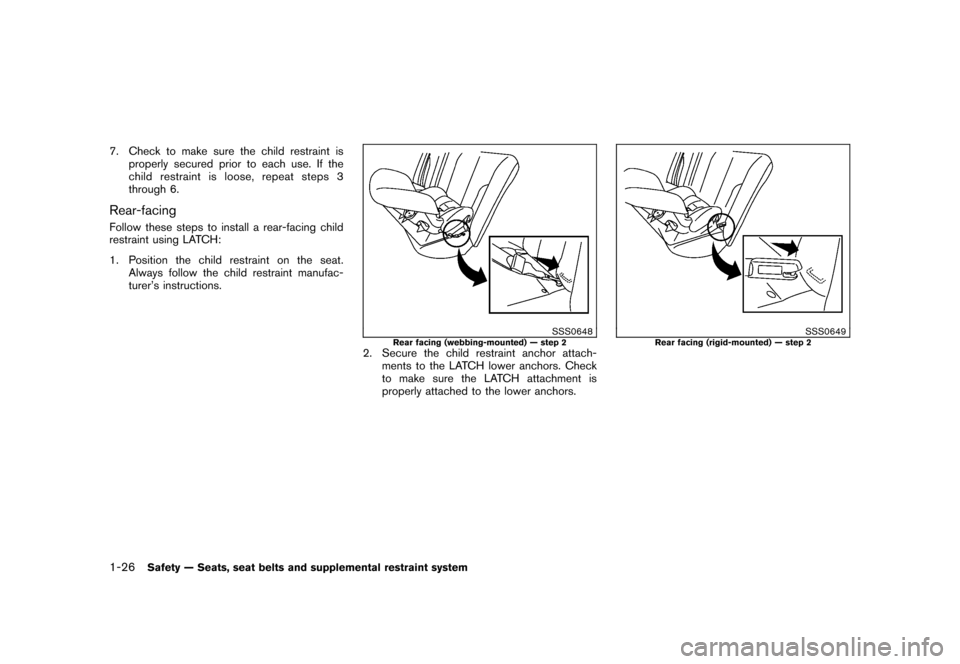
Black plate (38,1)
Model "S35-D" EDITED: 2007/ 12/ 19
7. Check to make sure the child restraint is
properly secured prior to each use. If the
child restraint is loose, repeat steps 3
through 6.Rear-facingFollow these steps to install a rear-facing child
restraint using LATCH:
1. Position the child restraint on the seat.
Always follow the child restraint manufac-
turer’s instructions.
SSS0648
Rear facing (webbing-mounted) — step 2
2. Secure the child restraint anchor attach-
ments to the LATCH lower anchors. Check
to make sure the LATCH attachment is
properly attached to the lower anchors.
SSS0649
Rear facing (rigid-mounted) — step 2
1-26
Safety — Seats, seat belts and supplemental restraint system
Page 40 of 309
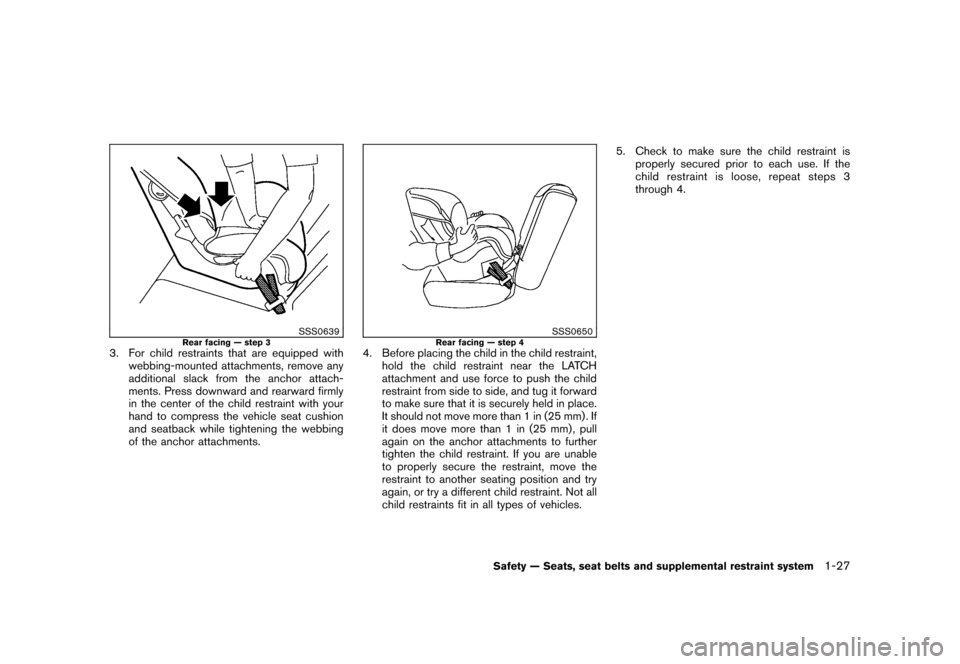
Black plate (39,1)
Model "S35-D" EDITED: 2007/ 12/ 19
SSS0639
Rear facing — step 3
3. For child restraints that are equipped with
webbing-mounted attachments, remove any
additional slack from the anchor attach-
ments. Press downward and rearward firmly
in the center of the child restraint with your
hand to compress the vehicle seat cushion
and seatback while tightening the webbing
of the anchor attachments.
SSS0650
Rear facing — step 4
4. Before placing the child in the child restraint,
hold the child restraint near the LATCH
attachment and use force to push the child
restraint from side to side, and tug it forward
to make sure that it is securely held in place.
It should not move more than 1 in (25 mm) . If
it does move more than 1 in (25 mm) , pull
again on the anchor attachments to further
tighten the child restraint. If you are unable
to properly secure the restraint, move the
restraint to another seating position and try
again, or try a different child restraint. Not all
child restraints fit in all types of vehicles.5. Check to make sure the child restraint is
properly secured prior to each use. If the
child restraint is loose, repeat steps 3
through 4.
Safety — Seats, seat belts and supplemental restraint system
1-27
Page 41 of 309
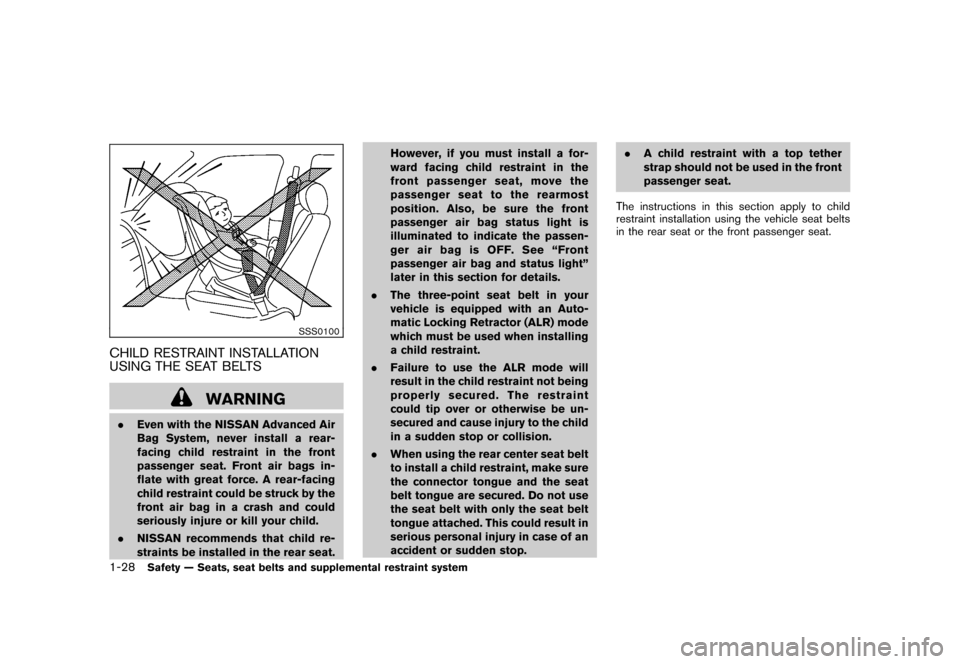
Black plate (40,1)
Model "S35-D" EDITED: 2007/ 12/ 19
SSS0100
CHILD RESTRAINT INSTALLATION
USING THE SEAT BELTS
WARNING
.Even with the NISSAN Advanced Air
Bag System, never install a rear-
facing child restraint in the front
passenger seat. Front air bags in-
flate with great force. A rear-facing
child restraint could be struck by the
front air bag in a crash and could
seriously injure or kill your child.
.NISSAN recommends that child re-
straints be installed in the rear seat.However, if you must install a for-
ward facing child restraint in the
front passenger seat, move the
passenger seat to the rearmost
position. Also, be sure the front
passenger air bag status light is
illuminated to indicate the passen-
ger air bag is OFF. See “Front
passenger air bag and status light”
later in this section for details.
.The three-point seat belt in your
vehicle is equipped with an Auto-
matic Locking Retractor (ALR) mode
which must be used when installing
a child restraint.
.Failure to use the ALR mode will
result in the child restraint not being
properly secured. The restraint
could tip over or otherwise be un-
secured and cause injury to the child
in a sudden stop or collision.
.When using the rear center seat belt
to install a child restraint, make sure
the connector tongue and the seat
belt tongue are secured. Do not use
the seat belt with only the seat belt
tongue attached. This could result in
serious personal injury in case of an
accident or sudden stop..A child restraint with a top tether
strap should not be used in the front
passenger seat.
The instructions in this section apply to child
restraint installation using the vehicle seat belts
in the rear seat or the front passenger seat.1-28
Safety — Seats, seat belts and supplemental restraint system
Page 42 of 309
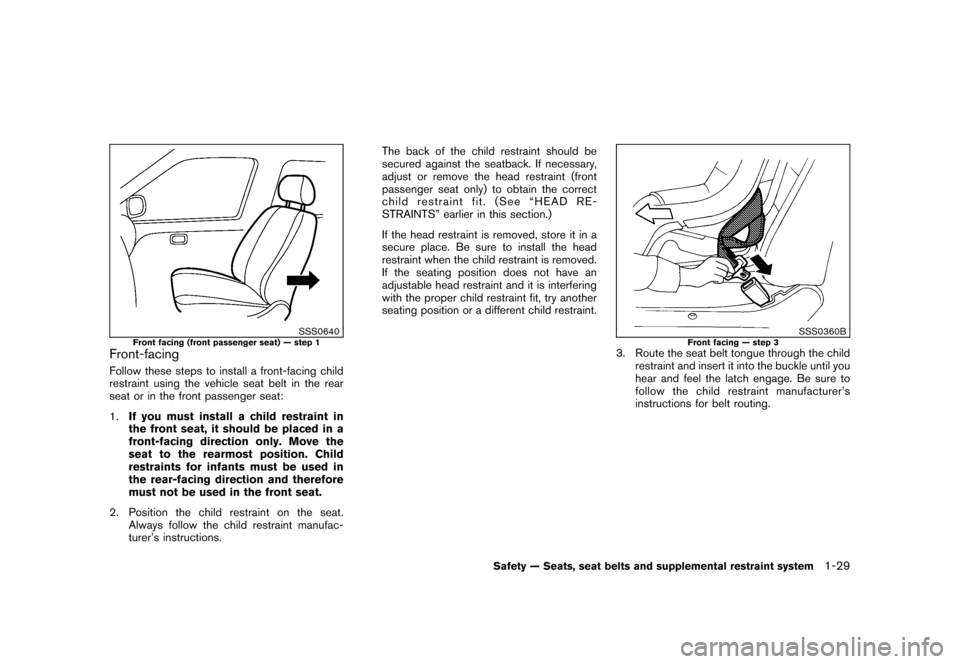
Black plate (41,1)
Model "S35-D" EDITED: 2007/ 12/ 19
SSS0640
Front facing (front passenger seat) — step 1
Front-facingFollow these steps to install a front-facing child
restraint using the vehicle seat belt in the rear
seat or in the front passenger seat:
1.If you must install a child restraint in
the front seat, it should be placed in a
front-facing direction only. Move the
seat to the rearmost position. Child
restraints for infants must be used in
the rear-facing direction and therefore
must not be used in the front seat.
2. Position the child restraint on the seat.
Always follow the child restraint manufac-
turer’s instructions.The back of the child restraint should be
secured against the seatback. If necessary,
adjust or remove the head restraint (front
passenger seat only) to obtain the correct
child restraint fit. (See “HEAD RE-
STRAINTS” earlier in this section.)
If the head restraint is removed, store it in a
secure place. Be sure to install the head
restraint when the child restraint is removed.
If the seating position does not have an
adjustable head restraint and it is interfering
with the proper child restraint fit, try another
seating position or a different child restraint.
SSS0360B
Front facing — step 3
3. Route the seat belt tongue through the child
restraint and insert it into the buckle until you
hear and feel the latch engage. Be sure to
follow the child restraint manufacturer’s
instructions for belt routing.
Safety — Seats, seat belts and supplemental restraint system
1-29